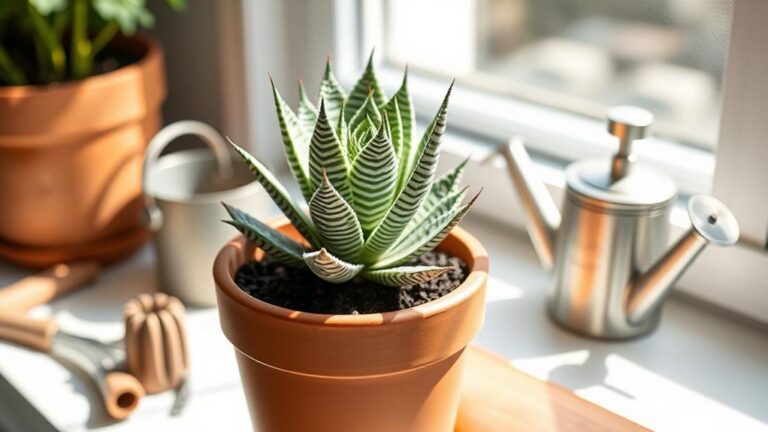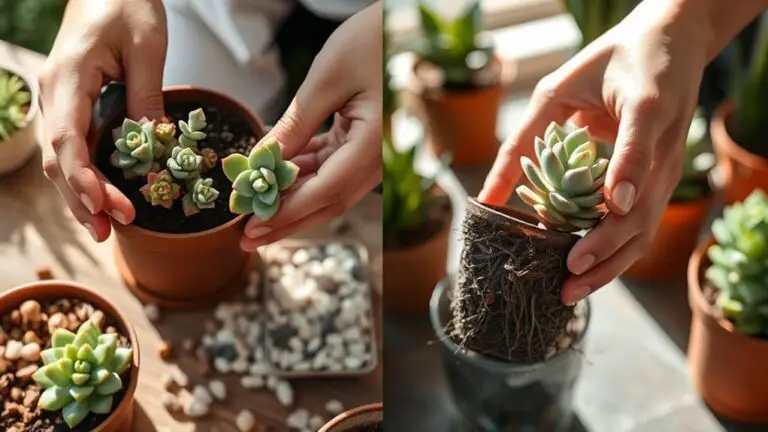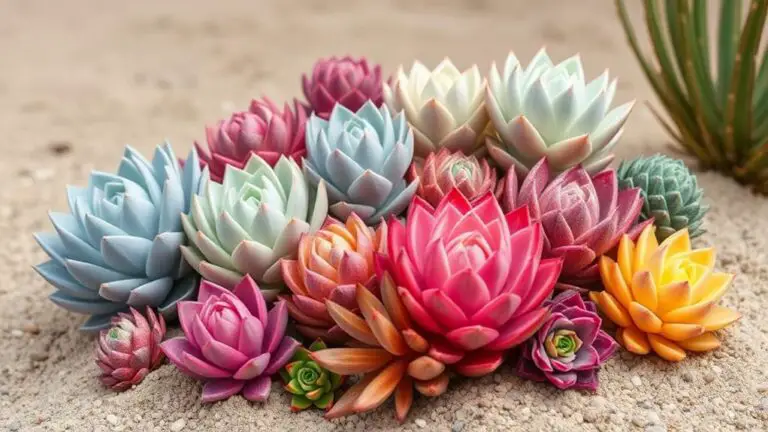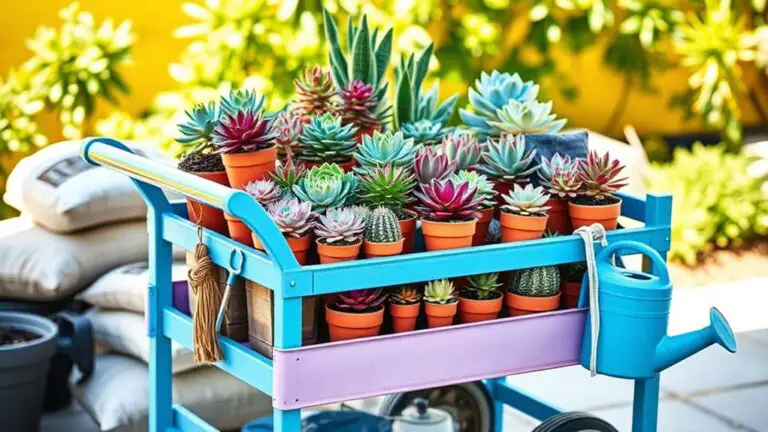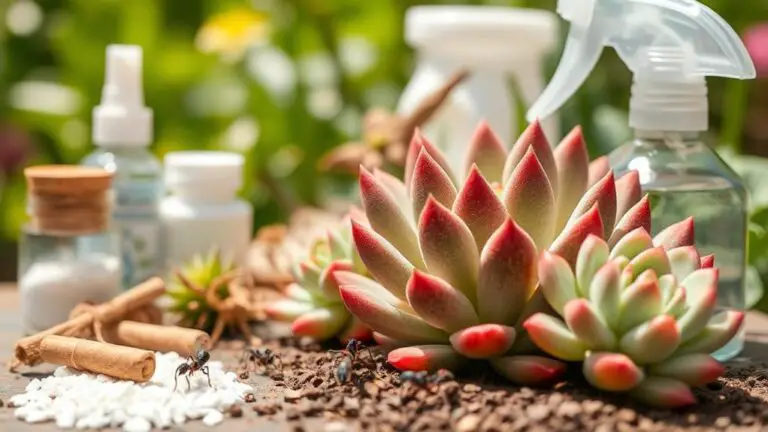How to Use Charcoal for Good Succulents
To cultivate robust succulents, you should consider the strategic use of activated charcoal. By integrating one tablespoon of it per cup into your potting mix, you can greatly enhance drainage and air circulation. You can also place a 1-2 inch layer of larger charcoal pieces at the bottom of your pots to improve moisture absorption and prevent root rot. Additionally, sprinkling charcoal powder on the soil surface can deter pests. However, it is crucial to use charcoal specifically designed for gardening to avoid any harmful additives. Curious about the next steps?
Understanding Activated Charcoal

Activated charcoal, made by heating charcoal to high temperatures, is renowned for its myriad tiny pores that boost its absorbent qualities. This makes activated charcoal a fantastic addition to your plant care routine, especially for succulents.
It's commonly made from coconut shells, coal, and wood, but coconut shells are the most popular. They've a high porosity and are renewable, making them environmentally friendly.
When you add activated charcoal to your potting mix, you'll notice several benefits. First, it improves drainage. Good drainage is essential for succulents because it prevents water from sitting in the soil, which can cause root rot. The tiny pores in activated charcoal help water move through the soil more effectively.
Another great benefit is that activated charcoal helps reduce mold growth. Mold can be a big problem in humid environments, but activated charcoal's absorbent properties keep humidity levels balanced. This is especially important for succulents, which prefer drier conditions.
Remember to use activated charcoal specifically designed for gardening. Regular grilling charcoal can contain harmful additives that could damage your plants.
Types of Charcoal
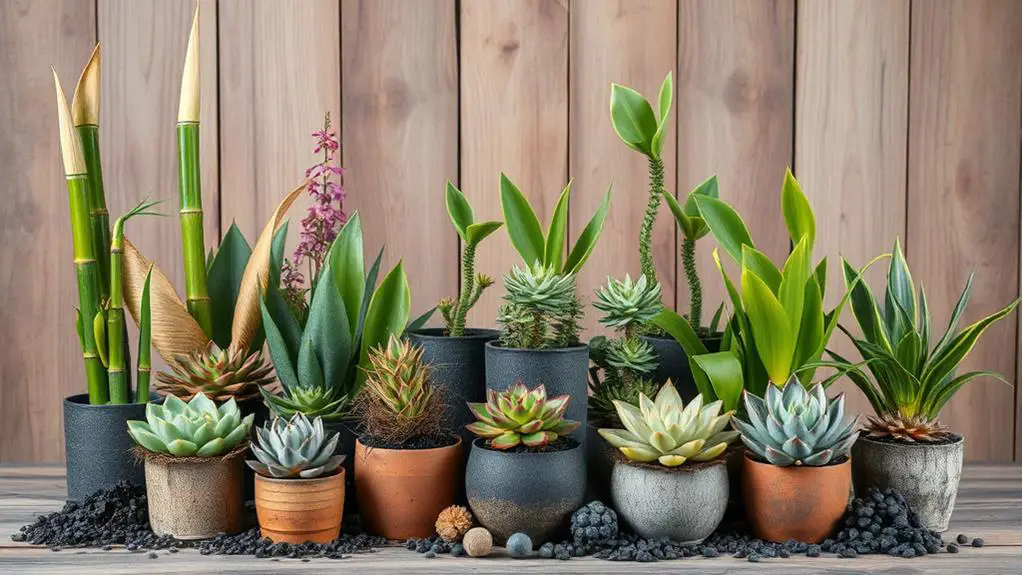
When picking charcoal for your succulents, it's important to know the different types and their benefits.
Activated charcoal, especially coconut shell-based, is a favorite for its high porosity and minimal dust.
Horticultural charcoal is also great because it's specifically made for gardening, ensuring your plants stay healthy.
Activated Charcoal Variations
Choosing the right type of activated charcoal for your succulents can greatly impact their health and growth. Activated charcoal comes in several variations, each with unique properties. Understanding these can help you make the best choice for your plants.
- Coconut Shells: This type is highly porous and renewable, making it a popular choice for gardening. It's low in dust and free from harmful chemicals, ensuring a safe environment for your succulents.
- Coal Base: Derived from fossil fuels, coal-based activated charcoal has a consistent density and low dust content. However, it's more suited for industrial uses rather than gardening.
- Wood Base: This variation strikes a balance between coal and coconut shell. It's renewable and offers varied pore sizes that can benefit soil health, making it a practical option for gardeners.
- Horticultural Charcoal: Specifically designed for gardening, horticultural charcoal is free from harmful additives you might find in regular grilling charcoal.
- Grilling Charcoal: Avoid using this type, as it often contains additives and chemicals that can harm your plants.
Benefits for Gardening
Incorporating the right type of charcoal into your gardening routine offers numerous benefits for succulent health. Activated charcoal, especially from coconut shells, is incredibly porous. This makes it perfect for improving soil drainage and preventing root rot, a common issue with succulents.
When you mix activated charcoal into your potting soil at a 1:4 ratio, it considerably enhances drainage and air circulation, which are essential for healthy succulent growth.
Horticultural charcoal is another excellent option. It's specifically designed for gardening use and helps maintain soil health by absorbing toxins and impurities. This means your succulents will have a cleaner, healthier environment to grow in.
Additionally, this type of charcoal can act as a natural pest repellent, keeping unwanted bugs at bay without harmful chemicals.
Bamboo charcoal is an eco-friendly alternative that retains nutrients well. This makes it beneficial for the overall health of your succulents, ensuring they get the nutrients they need to thrive.
However, avoid using regular charcoal, like the kind used for grilling. It contains harmful additives and lacks the necessary pore structure to be effective in gardening.
Choosing the Right Type
Selecting the right type of charcoal for your succulents can make a considerable difference in their health and growth. As a plant lover, you have several options when it comes to different materials of charcoal, each with unique benefits.
Here's a quick guide to help you choose the best type for your succulent garden:
- Activated Charcoal: The horticultural variety is perfect for enhancing soil health. It's specially designed for gardening.
- Coconut Shell-based Activated Charcoal: This is highly porous and renewable, making it an eco-friendly choice.
- Coal-based Activated Charcoal: Known for its consistent density and low dust, it improves soil drainage reliably.
- Bamboo Charcoal: Another eco-friendly option that retains nutrients well, ensuring your succulents thrive.
- Avoid Regular Grilling Charcoal: This type often contains harmful additives that can hurt your plants.
Using charcoal at the bottom of your succulent pots can considerably improve drainage and prevent root rot. Activated charcoal is particularly effective because it helps absorb toxins and excess moisture.
Always opt for eco-friendly choices when possible to support both your plants and the environment. With these tips, you'll be well on your way to growing healthy, happy succulents!
Benefits for Succulents

Activated charcoal's benefits for succulents are considerable and multifaceted.
First, it markedly improves soil drainage by enhancing air circulation around the roots. Good drainage is crucial for succulents because it prevents root rot, a common issue when water accumulates around the roots. This means your plants will have a better chance to thrive.
Another key benefit is that activated charcoal absorbs excess moisture. This helps maintain the right humidity levels, reducing the risk of overwatering, which can be deadly for succulents. By keeping the soil at an ideal moisture level, your plants can grow healthier and stronger.
Activated charcoal also has natural filtering properties that remove toxins from the soil. This contributes to healthier plant growth by ensuring that your succulents aren't exposed to harmful substances.
Additionally, it helps stabilize the pH levels in the soil, which is crucial for your succulents' overall health.
Mixing Charcoal With Soil

Blending activated charcoal with your potting soil can greatly enhance the environment for your succulents. By mixing it in at a ratio of 1:4, you'll improve soil aeration and drainage, making it easier for your plants to thrive. Activated charcoal absorbs harmful chemicals and toxins, ensuring a healthier habitat for your succulents.
Here are some key steps to follow:
- Mixing Ratio: Use one tablespoon of powdered activated charcoal per cup of potting mix.
- Soil Aeration: Enhances the soil structure, allowing roots to grow freely.
- Chemical Absorption: Helps to absorb harmful substances that could damage your plants.
- Mold Prevention: Reduces mold growth on the soil surface, keeping your succulents healthy.
- Pest Control: Deters pests naturally, creating a safer environment.
Using horticultural-grade activated charcoal specifically designed for gardening will yield the best results.
You'll notice that your succulents seem more vibrant and stable with this improved potting mix.
Don't worry if you're new to this—just follow these steps and your plants will thank you.
Charcoal Layer for Drainage
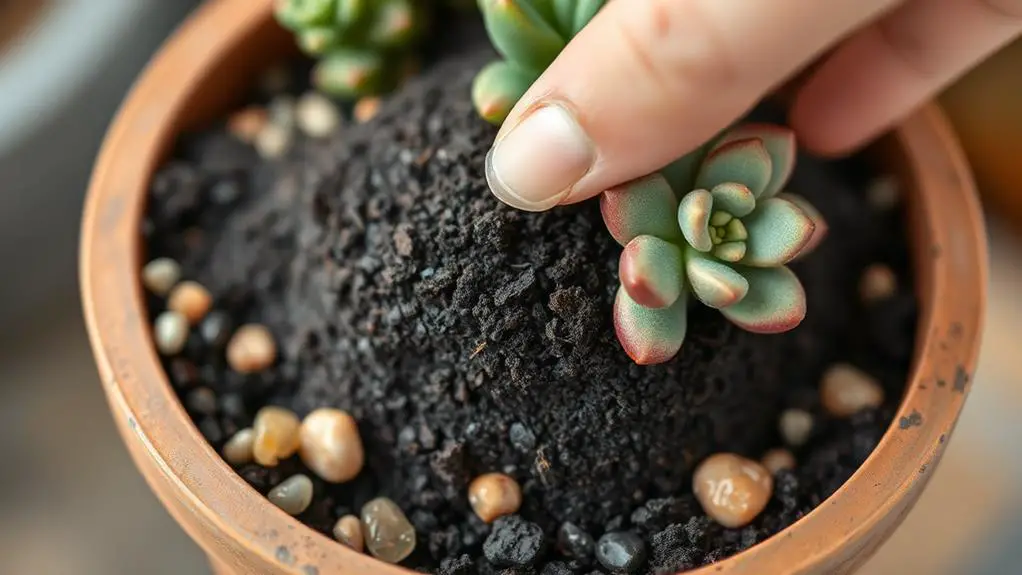
Adding a charcoal layer at the bottom of your succulent pots is a game-changer for drainage. This simple step can make a big difference in keeping your succulents healthy.
Start by using larger pieces of activated charcoal, about the size of gravel. These pieces help improve airflow and water movement within the soil, making sure excess water flows away from your plant's roots.
To create an effective charcoal layer, aim for a thickness of about 1-2 inches. This depends on the size of your pot, but this range is typically enough to absorb excess moisture. By doing this, you reduce the risk of root rot, which is a common problem for succulents.
Not only does the charcoal layer enhance drainage, but it also acts as a natural filter. It captures toxins and impurities from the water, preventing them from harming your succulent. This is essential for maintaining the health and liveliness of your plants.
Incorporating a charcoal layer helps in maintaining ideal humidity levels in the soil, which is important for succulent growth.
With this simple addition, your succulents will thrive, and you'll have healthier, happier plants.
Using Charcoal as a Pest Repellent
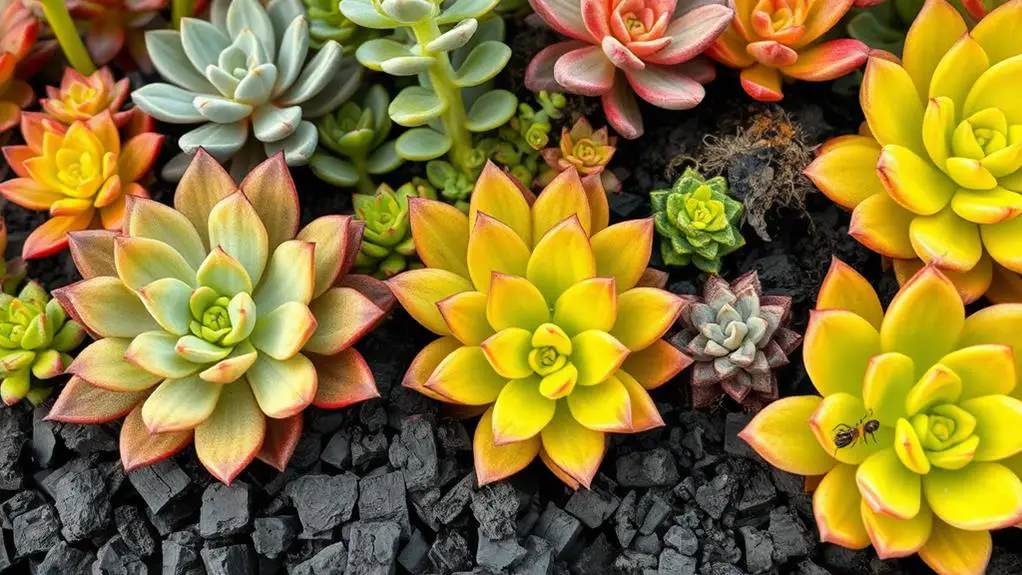
Although succulents are generally hardy, pests can still be a problem. Thankfully, you can use activated charcoal to help keep those pesky insects at bay. Activated charcoal works wonders by absorbing toxins and harmful chemicals in the soil, making it less inviting for pests and promoting a healthier plant environment.
Here's how you can use activated charcoal as a pest repellent:
- Sprinkle a thin layer of activated charcoal powder on the soil surface. This helps repel pests and reduces mold growth.
- Incorporate activated charcoal into your potting mix. It maintains ideal soil conditions, preventing excess moisture where pests thrive.
- Use the porous structure of activated charcoal to trap and absorb pest-related odors, making your planting area less attractive to insects.
- Regularly monitor moisture levels and combine with activated charcoal for enhanced pest deterrence.
- Ensure your succulents get adequate sunlight alongside the use of activated charcoal to boost plant health and repel pests.
Important Precautions
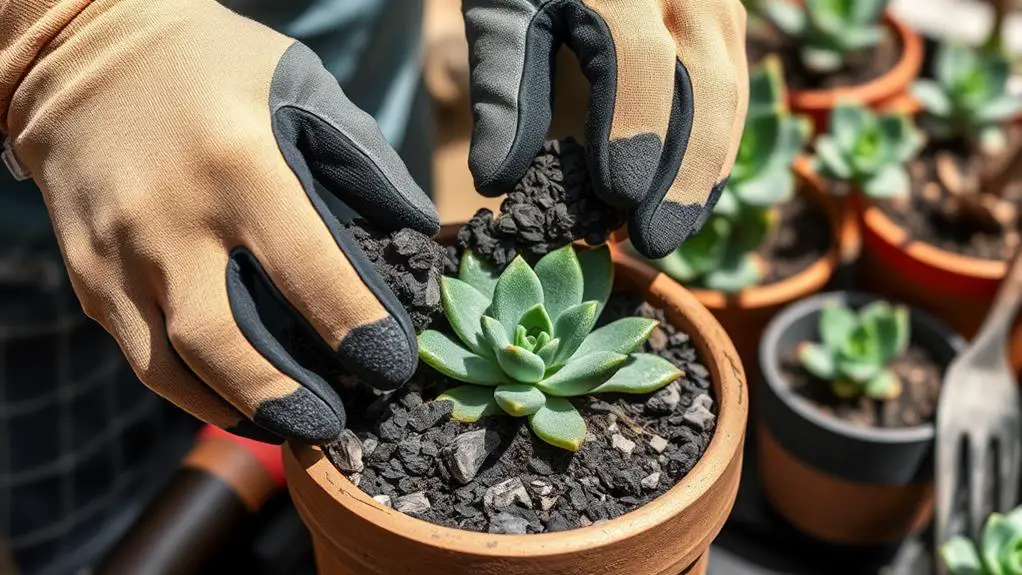
When using activated charcoal for your succulents, it's vital to take certain precautions to guarantee their health. First, always use activated charcoal specifically labeled for gardening. Regular grilling charcoal might contain harmful chemicals like ammonia that can damage your plants.
It's important to verify the charcoal is free from additives and impurities, as these can negatively impact soil health and plant growth.
Another significant point is to avoid overusing activated charcoal. While it's beneficial, too much can absorb excess moisture, drying out the soil and hindering your succulents' growth.
Keep an eye on the amount you're adding to avoid this issue.
Monitoring the soil pH after applying activated charcoal is also important. Charcoal can affect nutrient availability for your succulents, so maintaining a balanced environment helps them thrive.
Use a simple pH test kit to check and adjust if needed.
Additional Tips for Succulent Care
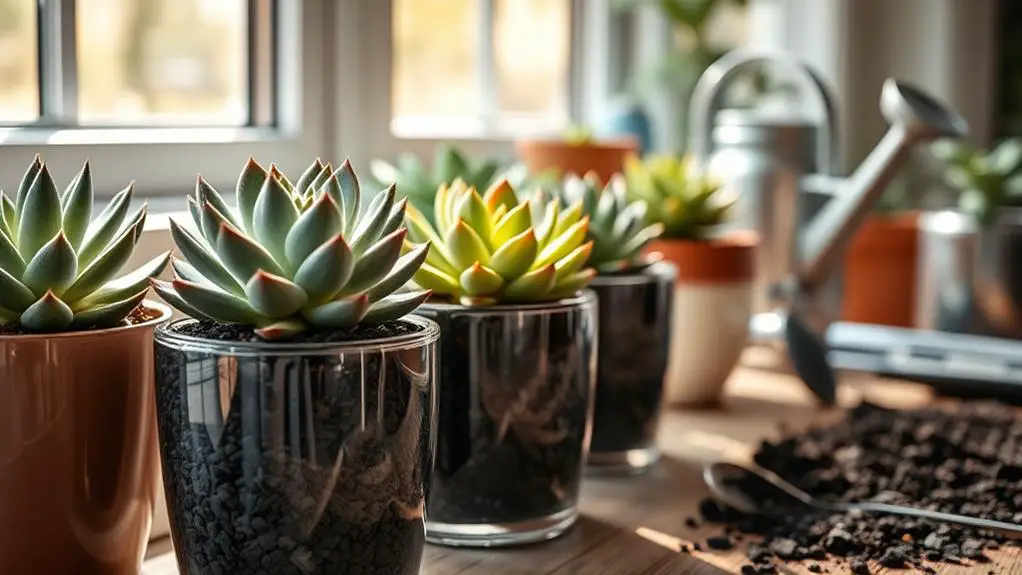
Caring for succulents requires a bit of know-how, but with these additional tips, you'll keep your plants thriving.
Start by ensuring your succulents get enough sunlight. Place them in bright, indirect light for at least 6 hours a day. This helps promote healthy growth and keeps them looking vibrant.
Water sparingly. Let the soil dry out completely between watering sessions. Overwatering can lead to root rot, which is a common issue with succulents.
Using well-draining soil is essential. Incorporate activated charcoal into the mix to enhance drainage and prevent moisture retention. This also helps with water purification, ensuring your soil stays fresh.
Fertilize during the growing season, which is spring and summer. Use a diluted, balanced fertilizer to support your succulents' health and growth.
Finally, regularly inspect your succulents for pests and diseases. Promptly address any issues to maintain a healthy environment for your plants.
- Place succulents in bright, indirect light for 6 hours daily.
- Water sparingly and let soil dry out completely.
- Use well-draining soil with activated charcoal.
- Fertilize with diluted, balanced fertilizer during growing season.
- Regularly check for pests and diseases, and treat promptly.
Frequently Asked Questions
How to Use Charcoal for Succulents?
Mix activated charcoal with potting soil (1:4) to improve drainage and prevent root rot. Sprinkle it on the soil surface to repel pests. Use larger chunks at the bottom of pots for better water absorption and air circulation.
Can I Mix Charcoal With Potting Soil?
Yes, you can mix charcoal with potting soil. Use a 1:4 ratio (charcoal to soil) to enhance drainage. Activated charcoal absorbs excess moisture and prevents root rot, ensuring your succulents thrive. Stick to horticultural charcoal.
How Do You Use Charcoal to Improve Soil?
Mix activated charcoal with potting soil at a 1:4 ratio for better drainage and air circulation. Add a charcoal layer at the pot's bottom, and sprinkle powdered charcoal on the surface to deter pests and mold.
How to Use Activated Charcoal for Plants?
Mix activated charcoal with potting soil at a 1:4 ratio. Sprinkle powdered charcoal on the surface for pest control. Place larger chunks at the pot's bottom for water absorption. Use horticultural-grade charcoal to avoid harmful chemicals.
Conclusion
Using charcoal for your succulents can make a big difference in their health and growth. By mixing it into the soil, adding a drainage layer, and sprinkling it on top, you'll improve drainage, prevent root rot, and keep pests away. Remember to use gardening-specific charcoal to avoid harmful additives. With these tips, you're well on your way to thriving succulents. Happy gardening, and don't hesitate to try these methods for healthier plants!


